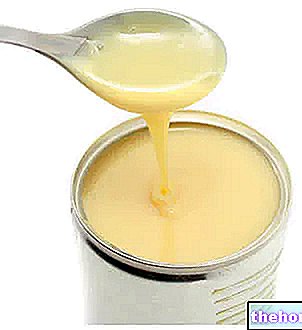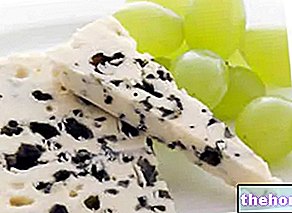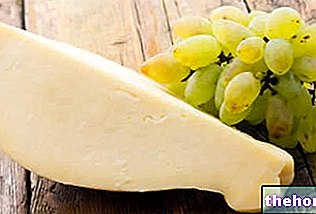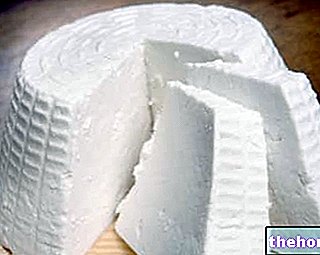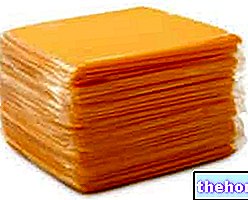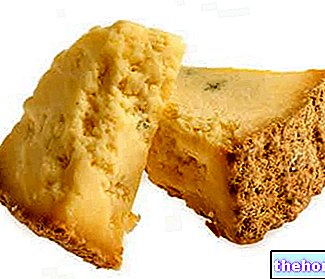Classification of cheeses
The classification of cheeses, by virtue of the great abundance of varieties (about 2000 worldwide), can be done:
- according to the type of milk used (goat, sheep, cow, buffalo and mixed cheeses);
- according to the curd coagulation method (acid or rennet);
- according to the consistency of the pasta or the water content (fresh, soft, semi-hard, hard, grated cheeses);
- according to the cooking temperature (raw cheeses T 48 ° C);
- according to the maturation time (fresh cheeses with extra rapid maturation of 2-3 days; rapid within 15 days; short maturing within 30 days; medium maturing within 6 months; long maturing, slow within 1 year, and very slow, over 1 year);
- according to the fat content (low-fat, semi-fat, fat cheeses, double cream);
Other types of cheese
FILATA PASTA CHEESE
A curd is first prepared by adding rennet, which is left to mature in whey for at least 3 hours, up to a pH of 5.2-5.3. The curd is then melted in boiling water, pulled into threads and appropriately shaped. This process determines the partial demineralization (formation of monocalcium paracaseinate) linked to the formation of lactic acid. Mozzarella, Fior di latte, Provolone, Scamorza etc. are obtained.
MELTED CHEESES
They are obtained by fusion of cheeses of various types and of different ripeness (generally sweet). The matter is first ground and mixed; melting takes place at 70-75 ° C under reduced pressure; butter, margarine, dyes, but above all melting salts (phosphates, polyphosphates and sodium citrates) can be added, which increase spreadability and maintain hydration.
MASCARPONE CHEESE
It is a soft cheese that is obtained starting from milk cream (25-30% fat), heated to 80-90 ° C and added with citric acid. Coagulation is due to acidity and heat.
RICOTTA
It is obtained by coagulation of the whey coming from the cheese making. After the curd, the whey still contains proteins, minerals and a part of fats. It is heated to 75-80 ° C, the temperature at which the whey proteins coagulate; a precipitate is thus formed consisting of lactalbumin, small quantities of fat, lactose and mineral salts, which is left to drip for 12 hours and then placed in the molds.
Precisely due to the way it is produced, ricotta is not a cheese, but a dairy product, as it is outside the definition of the law. It is a noble product, because it is low in fat and lactose, but rich in proteins of very high biological value; it is also easily digestible.
Chemical composition (g / 100 g of fresh product) of ricotta from different origins
Nutritional value of cheese
Cheese is made up of water, proteins and fat, in a proportion of 50:25:25; however, these proportions show a rather high degree of variability, depending on the type and maturation period. Cheese is therefore a very energetic food, so much so that 100 g provide an average of 300 kcal (2/3 due to the lipid content), always with a certain difference between the various specialties (see cheese and calories)
The proteins are highly digestible, thanks to the hydrolysis of the caseins and the increase in the soluble fraction.
Carbohydrates are lacking; lactose, present in solution in the serum, is contained only in small quantities. For this reason, cheese is well tolerated even by those who do not digest lactose. It should be combined with starchy foods, such as bread, pasta and rice, to complete its nutritional profile.
Cheese is particularly rich in calcium, phosphorus, vitamin A and B vitamins (because it is a concentrated food). As in milk, we lack vitamin C and iron, so it is good to accompany it with vegetables.
One hundred grams of cheese (Parmesan) correspond, in nutritional value, to 200 g of veal, 160 g of ham and 300 g of fish (trout). Finally, remember that cheese, like meat and fish, must be considered a second course and not a treat to be consumed at the end of a meal.
Carbohydrates
available
Acid
lactic
Salts
minerals
From: Souci et al, 2000, supplemented
Bibliography
FOOD CHEMISTRY, Cabras and Martelli, Ed. Piccin
FOOD CHEMISTRY, vANNUCCHI HATS, Ed. Zanichelli
Other articles on "Cheeses: classification and nutritional value"
- cheese processing
- cheese
- cheese coagulation
- low-fat cheeses
- cheeses calories
- cheeses rich in calcium

